 As described in the previous post, I had managed to sweet-talk my way into another tour. This second tour would go to some other locations in the complex that I hadn’t seen.
As described in the previous post, I had managed to sweet-talk my way into another tour. This second tour would go to some other locations in the complex that I hadn’t seen.
Whereas yesterday was rainy, today we had great weather, so I arrived early and took some exterior pictures. This gigantic wooden (!) building is the “Globe of Science and Innovation” and was a gift to CERN from the people of Switzerland. It houses the “Universe Of Particles” exhibit, which was sadly closed the week I was there, apparently for renovations. The pictures of it look pretty damn cool — click and take a look.
Met up with my designated tour and boarded the bus. We’d be going to two locations — SM18 and CMS.
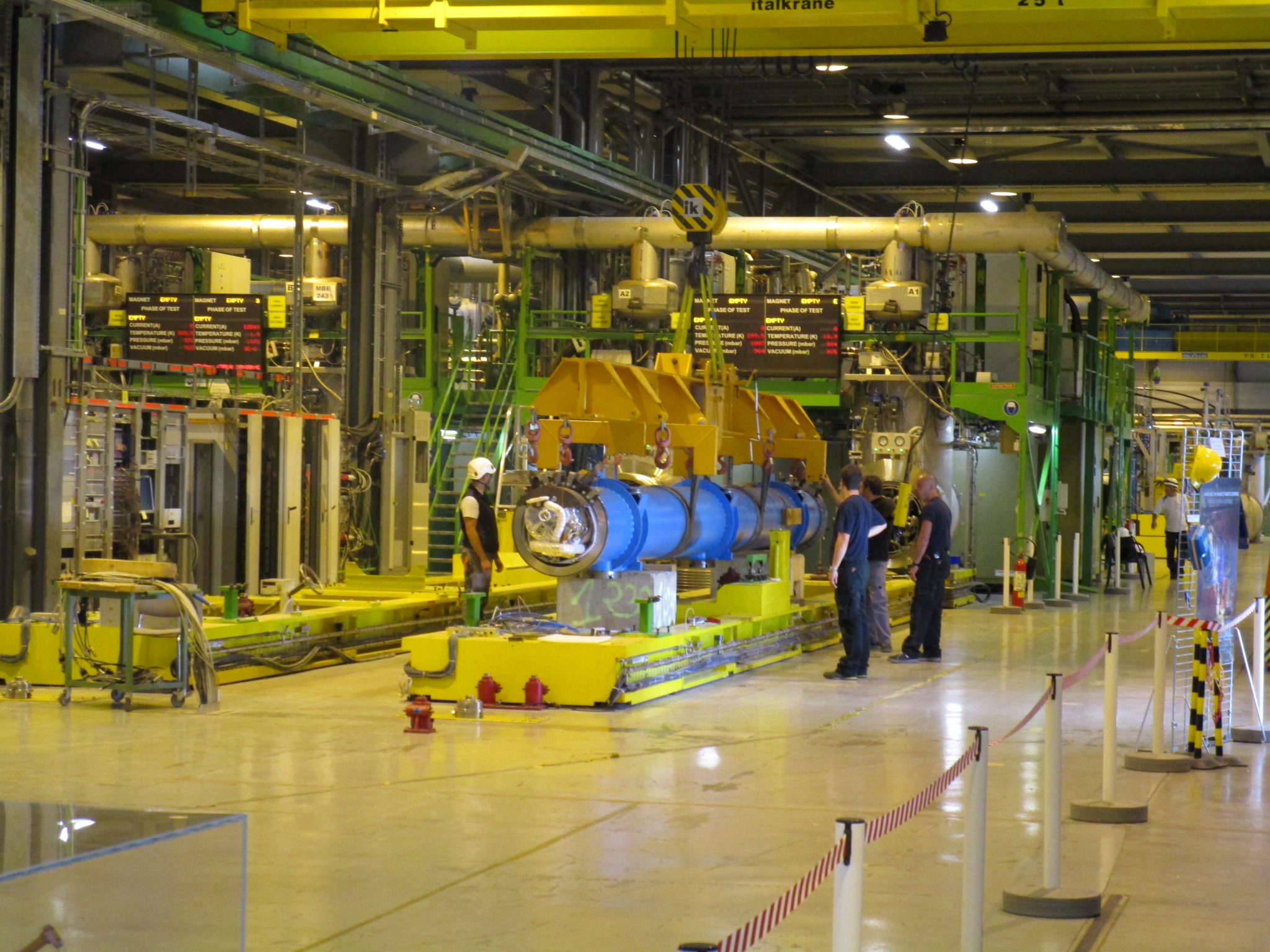 SM18 is the main testing facility for the magnets that are used in the LHC ring. I have no idea what “SM18” stands for — maybe “superconducting magnet” something. As I explained in the previous post, the accelerator ring uses extremely powerful magnets to bend the beam into a circle 27 km around. Even though the construction was completed in 2008, there are about 1600 magnet sections and there is bound to be repair and repalcement activity. This is especially true during a shutdown period such as 2013-2014, which is when they have their one chance to really take the thing apart and service it.
SM18 is the main testing facility for the magnets that are used in the LHC ring. I have no idea what “SM18” stands for — maybe “superconducting magnet” something. As I explained in the previous post, the accelerator ring uses extremely powerful magnets to bend the beam into a circle 27 km around. Even though the construction was completed in 2008, there are about 1600 magnet sections and there is bound to be repair and repalcement activity. This is especially true during a shutdown period such as 2013-2014, which is when they have their one chance to really take the thing apart and service it.
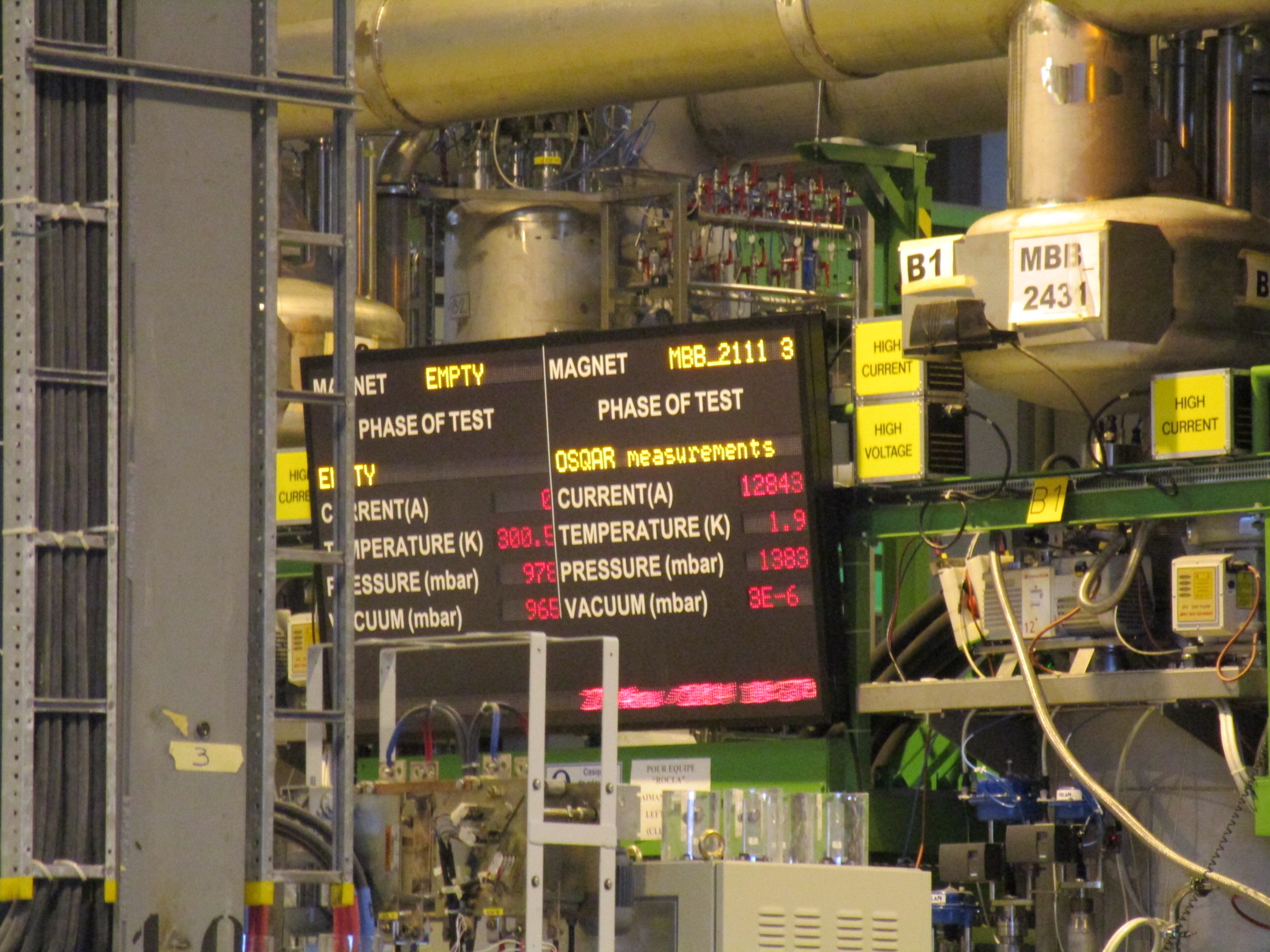 So what we got a glimpse of was a huge industrial space where they loaded in the dipole magnet sections, each about 15 meters long and weighing multiple tons, and ran them through a series of tests. I can’t tell you how excited I was to see them actually moving the sections around, actually testing them, showing actual results on the large aerial displays. If you look closely at the numbers in this picture, on the display you will see:
So what we got a glimpse of was a huge industrial space where they loaded in the dipole magnet sections, each about 15 meters long and weighing multiple tons, and ran them through a series of tests. I can’t tell you how excited I was to see them actually moving the sections around, actually testing them, showing actual results on the large aerial displays. If you look closely at the numbers in this picture, on the display you will see:
– 12843 Amps (insanely high electrical current) – 1.9 Kelvin (extremely low temperature)
Very cool, literally!
 We were only allowed into a little corner of the building, but they had all sorts of cool models and hardware on display for us. Models of the building with little trucks showing how gear moved in and out. Models of the tube with all of the magnets and superconducting wires packed around it. Various hardware like an actual dipole section with the side cut out of it so you could get a view of the innrds. A cryogenic valve. Dipole magnets, quadrupole magnets, sextupole magnets, oh my!
We were only allowed into a little corner of the building, but they had all sorts of cool models and hardware on display for us. Models of the building with little trucks showing how gear moved in and out. Models of the tube with all of the magnets and superconducting wires packed around it. Various hardware like an actual dipole section with the side cut out of it so you could get a view of the innrds. A cryogenic valve. Dipole magnets, quadrupole magnets, sextupole magnets, oh my!
 Back onto the bus and onwards through the French / Swiss countryside, with beautiful views of the Jura mountains.
Back onto the bus and onwards through the French / Swiss countryside, with beautiful views of the Jura mountains.
Up next: a visit to the CMS complex. Similarly to yesterday’s LHCb, the Compact Muon Solenoid (CMS) experiment is located at a point along the LHC ring where the two beams are corssed to produce collisions.  However CMS is contained within a gigantic cavern, much bigger than LHCb’s — only the ATLAS cavern matches it in size. And ATLAS was already sealed up getting ready for operations, so CMS would be my one chance to see one of the big LHC experiments.
However CMS is contained within a gigantic cavern, much bigger than LHCb’s — only the ATLAS cavern matches it in size. And ATLAS was already sealed up getting ready for operations, so CMS would be my one chance to see one of the big LHC experiments.
 First they showed us around the surface level buildings, which contain various support items like cranes, gas storage tanks, air chillers, etc., but all on a very large scale.
First they showed us around the surface level buildings, which contain various support items like cranes, gas storage tanks, air chillers, etc., but all on a very large scale.
We passed through some security — not so much checking for authorization, rather checking for radiation, like in a nuclear power plant. After the nuclear screening, we stepped into a freight elevator (with some workers, 20 of us and 4 of them) and then descended waaaaaaaay down into the earth.
 I don’t even remember the distance now, but I did grab this snapshot looking UP the main access shaft to the surface. That bore was some 60 feet wide, originally sized to lower the gargantuan experiment components down to the cavern, but once they finished loading down the big items, they filled in the shaft with various other infrastructure — like a couple proper elevators, ventilation, and so forth.
I don’t even remember the distance now, but I did grab this snapshot looking UP the main access shaft to the surface. That bore was some 60 feet wide, originally sized to lower the gargantuan experiment components down to the cavern, but once they finished loading down the big items, they filled in the shaft with various other infrastructure — like a couple proper elevators, ventilation, and so forth.
 As we worked our way closer to the cavern, we passed room after room of support equipment. Not everything has to be located right inside the experiment area proper, but it also can’t be located too far away (like at the surface), because then the computer communications would slow down. They are dealing with massive amounts of data, literally the highest data flows on the planet, and in those applications the distance the communications has to travel is a factor.
As we worked our way closer to the cavern, we passed room after room of support equipment. Not everything has to be located right inside the experiment area proper, but it also can’t be located too far away (like at the surface), because then the computer communications would slow down. They are dealing with massive amounts of data, literally the highest data flows on the planet, and in those applications the distance the communications has to travel is a factor.
Finally, one more door, and the main cavern.

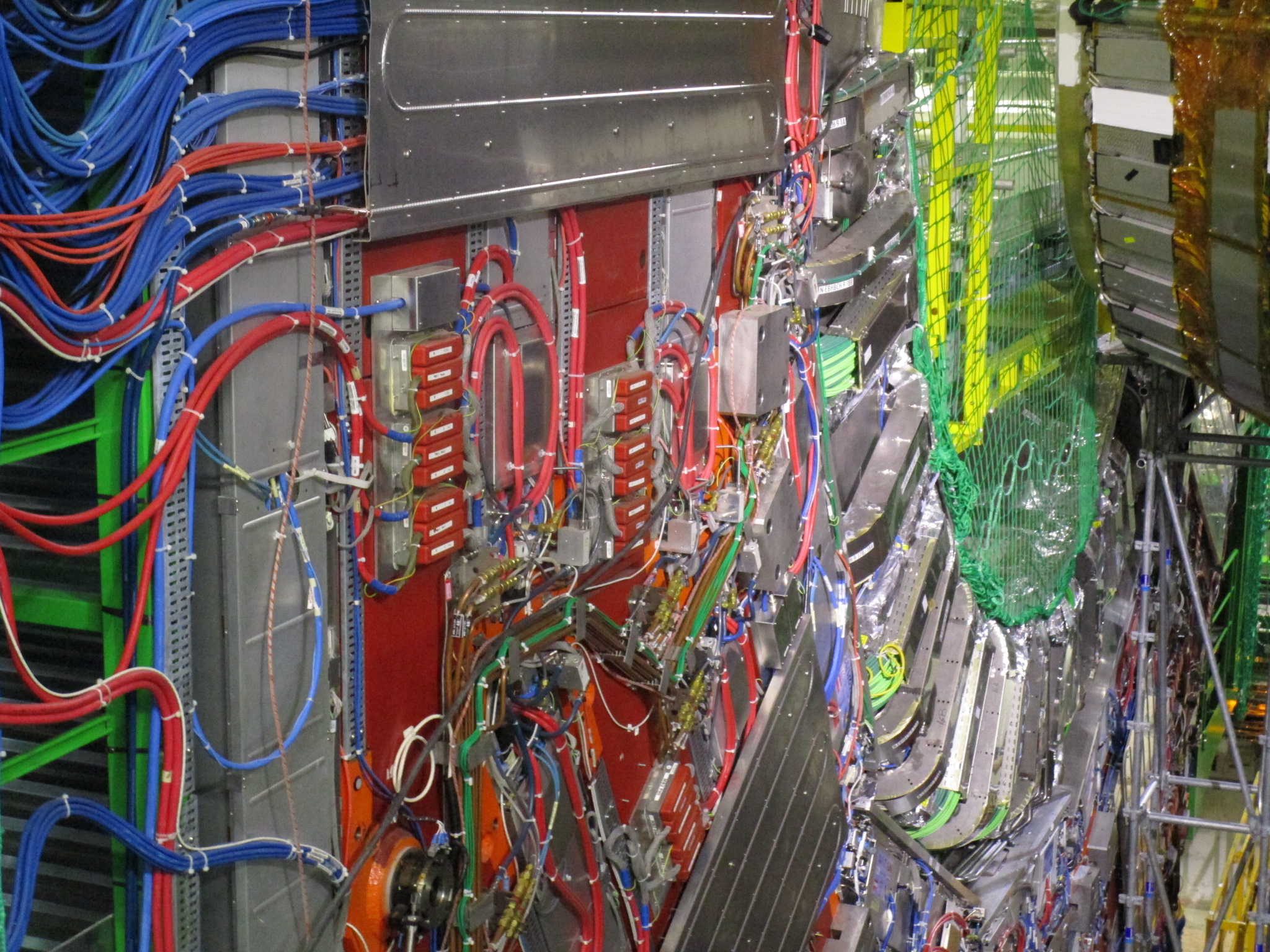 The picture above is of the center of the CMS experiment. When the LHC is operating, one beam crosses from left to right, and another one in the opposite direction, and they collider along the axis in the center. Surrounding that collision point is meters and tons of electronics to detect the various particles that spray away from the center. Pictured at right is a just a detail of part of the machine; click it to embiggen.
The picture above is of the center of the CMS experiment. When the LHC is operating, one beam crosses from left to right, and another one in the opposite direction, and they collider along the axis in the center. Surrounding that collision point is meters and tons of electronics to detect the various particles that spray away from the center. Pictured at right is a just a detail of part of the machine; click it to embiggen.
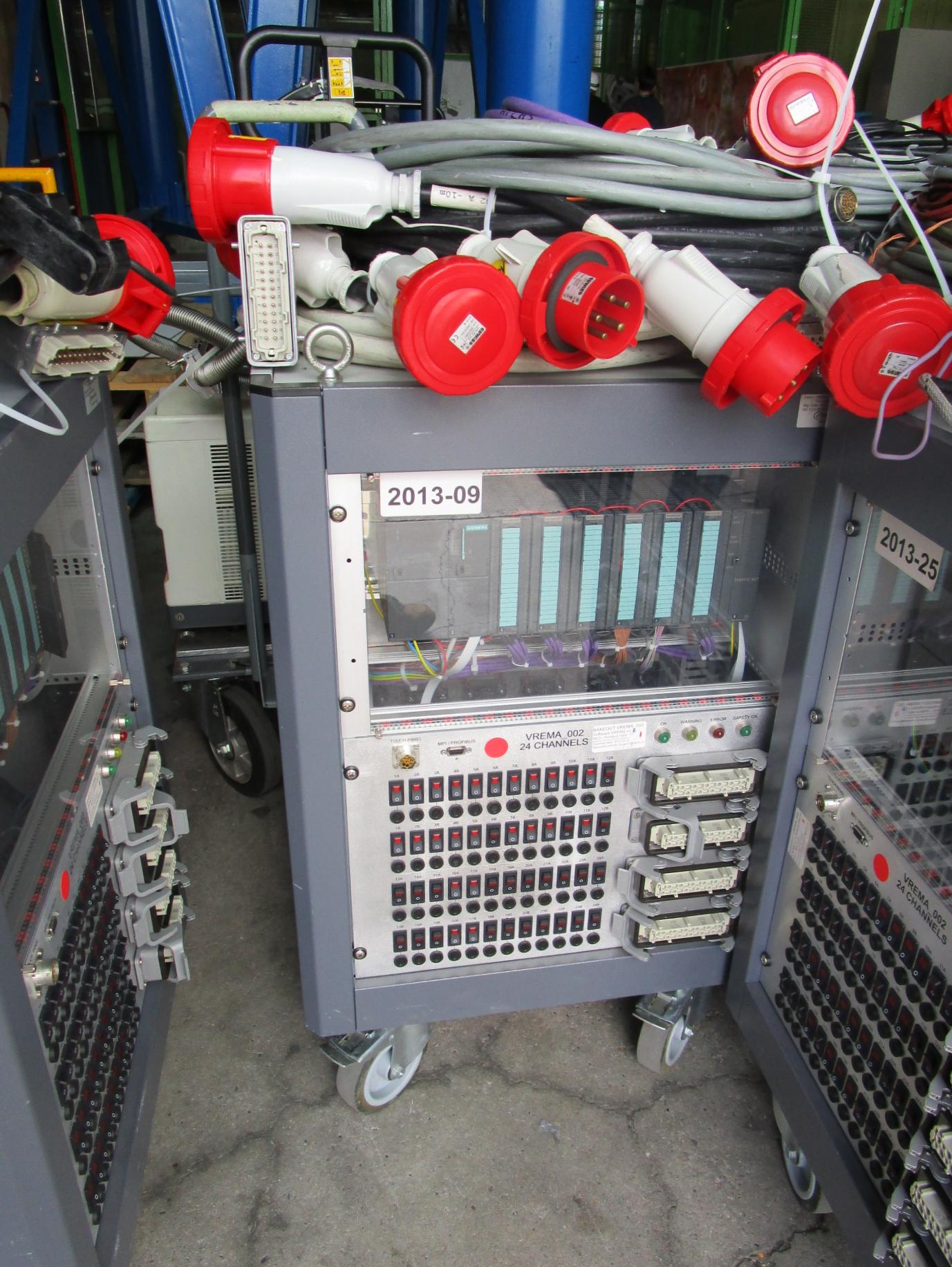 Aaand back up to the surface! Off in a corner I noticed some gear on carts, looked like data acquisition equipment. I just thought the connector were interesting — the big round ones are European-standard high power connectors, and the rectangular ones to the left are Amphenol parallel data connectors.
Aaand back up to the surface! Off in a corner I noticed some gear on carts, looked like data acquisition equipment. I just thought the connector were interesting — the big round ones are European-standard high power connectors, and the rectangular ones to the left are Amphenol parallel data connectors.
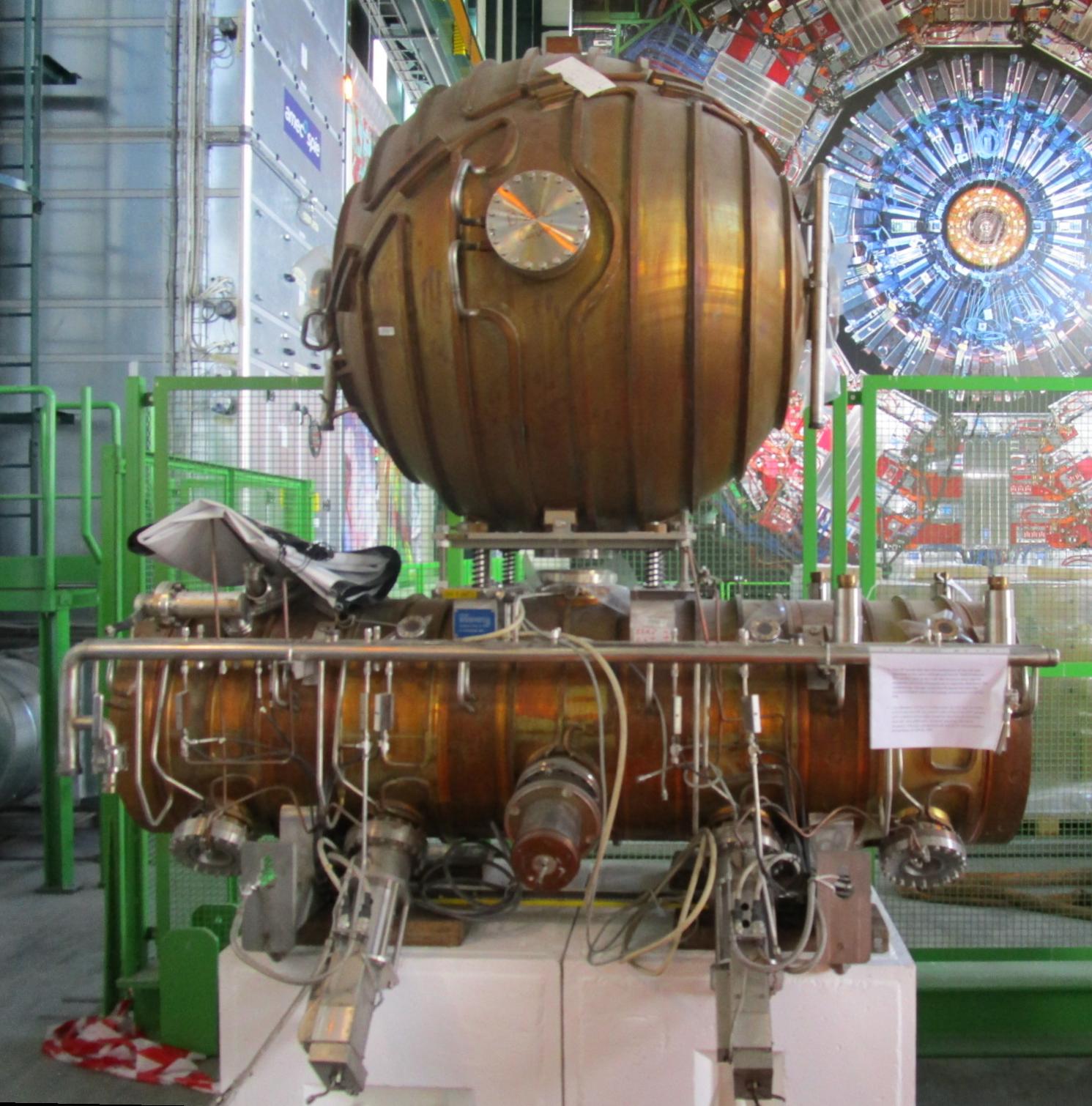 At the surface level, where they have a bit more room to spare, they have a few displays set up, such as this item reminiscent perhaps of a Jules Verne story, but actually an RF energy storage cavity for the old LEP that preceded the LHC in the same tunnel. These were the kinds of things that they had all over the courtyard at the visitors center, the courtyard that we could not actually get to, only peer at through windows. Special thanks to the person who stuck a sheet of paper on the thing explaining what it was!
At the surface level, where they have a bit more room to spare, they have a few displays set up, such as this item reminiscent perhaps of a Jules Verne story, but actually an RF energy storage cavity for the old LEP that preceded the LHC in the same tunnel. These were the kinds of things that they had all over the courtyard at the visitors center, the courtyard that we could not actually get to, only peer at through windows. Special thanks to the person who stuck a sheet of paper on the thing explaining what it was!
 The assembly hall at the surface was sized big enough to put together the major components of the experiment, which were then lowered through the access shaft. This picture shows the end of the hall with a gigantic life-sized picture of one of the components, before it was lowered, showing how it did literally barely fit in the hall (and the shaft, and the cavern).
The assembly hall at the surface was sized big enough to put together the major components of the experiment, which were then lowered through the access shaft. This picture shows the end of the hall with a gigantic life-sized picture of one of the components, before it was lowered, showing how it did literally barely fit in the hall (and the shaft, and the cavern).
 Our last stop at the CMS complex was to visit a modest exhibition they had set up showing the various components. Here you could get up close and personal with the parts. In this picture you can see the scale of the superconducting magnets at the very center of the beam.
Our last stop at the CMS complex was to visit a modest exhibition they had set up showing the various components. Here you could get up close and personal with the parts. In this picture you can see the scale of the superconducting magnets at the very center of the beam.
Back on the bus, back to the visitors center, and done. Thank you CERN!
Now, on to the rest of Geneva …